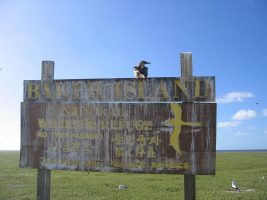
Are you a radio ham? That’s the slang for an amateur radio user. In the US you must pass a test to qualify to use most radio wavelengths and radio hams across the world love to chat. And they love to set themselves odd challenges.
This year, there will be a DXepedition to Baker Island.
Baker Island is an uninhabited atoll located just north of the equator in the central Pacific Ocean about 3,090 km (1,920 mi) southwest of Honolulu. The island lies almost halfway between Hawaii and Australia.
Located at 0°11′41″N 176°28′46″W, the island covers 2.1 km (0.81 sq mi), with 4.8 km (3.0 mi) of coastline. The climate is equatorial, with little rainfall, constant wind, and strong sunshine. The terrain is low-lying and sandy: a coral island surrounded by a narrow fringing reef with a depressed central area devoid of a lagoon with its highest point being 8 m (26 ft) above sea level.
The island now forms the Baker Island National Wildlife Refuge and is an unincorporated and unorganized territory of the U.S. which vouches for its defense. It is visited annually by the U.S. Fish and Wildlife Service. For statistical purposes, Baker is grouped with the United States Minor Outlying Islands.
Baker Island is also the last piece of land that experiences the New Year (earliest time zone) and one of only two that fall in time zone UTC-12.00. For some crazy reason 14 radio hams are planning to gather on this rock fourteen and spend 12 days responding to an estimates 75,000 radio calls from Baker Island fans across the world.
Want to know more? Check it out here. http://www.baker2018.net/index.html
Want to know more about getting your pepper’s friend radio ham license? You can run ham radios from your car and they don’t need cell towers, instead you create your own antenna or bounce signals off the clouds or use repeating stations fixed on high buildings.
Here’s some basic information. The test does involve a bit of physics but with enough studying you can kind remember the answers even if you’re not 100% sure you understand how they arrived at them!
FCC Licenses and Amateur Radio
Amateur Radio is regulated by the Federal Communications Commission (FCC) under the Communications Act of 1934. It is also subject to numerous international agreements. All Amateur Radio operators must be licensed. In the U.S., there are three license classes. The higher the class of license, the more frequencies are available. Earning each higher class license requires passing a more difficult examination. Although regulated by the FCC, license exams are given by volunteer groups of Amateur Radio operators. Operating under organizations called Volunteer Examiner Coordinators, volunteers administer and grade tests and report results to the FCC, which then issues the license. U.S. licenses are good for 10 years before renewal, and anyone may hold one except a representative of a foreign government. Learn More About Getting Licensed
License Restructuring
In December 1999, after a lengthy review of the Amateur Radio licensing system, the FCC began issuing major changes. In April 2000, the number of license classes dropped from six to the current three. In addition, in February 2007, the FCC discontinued requiring Morse code proficiency tests. The FCC issued these new regulations to streamline the licensing system and bring the Amateur Radio service into the digital age. While the new license system might not make it easier to get into Amateur Radio, licensed operators can move from the beginner to expert level more quickly.
The Technician License
The Technician class license is the entry-level license of choice for most new ham radio operators. To earn the Technician license requires passing one examination totaling 35 questions on radio theory, regulations and operating practices. The license gives access to all Amateur Radio frequencies above 30 megahertz, allowing these licensees the ability to communicate locally and most often within North America. It also allows for some limited privileges on the HF (also called “short wave”) bands used for international communications.
The General License
The General class license grants some operating privileges on all Amateur Radio bands and all operating modes. This license opens the door to world-wide communications. Earning the General class license requires passing a 35 question examination. General class licensees must also have passed the Technician written examination.
The Amateur Extra License
The Amateur Extra class license conveys all available U.S. Amateur Radio operating privileges on all bands and all modes. Earning the license is more difficult; it requires passing a thorough 50 question examination. Extra class licensees must also have passed all previous license class written examinations.
